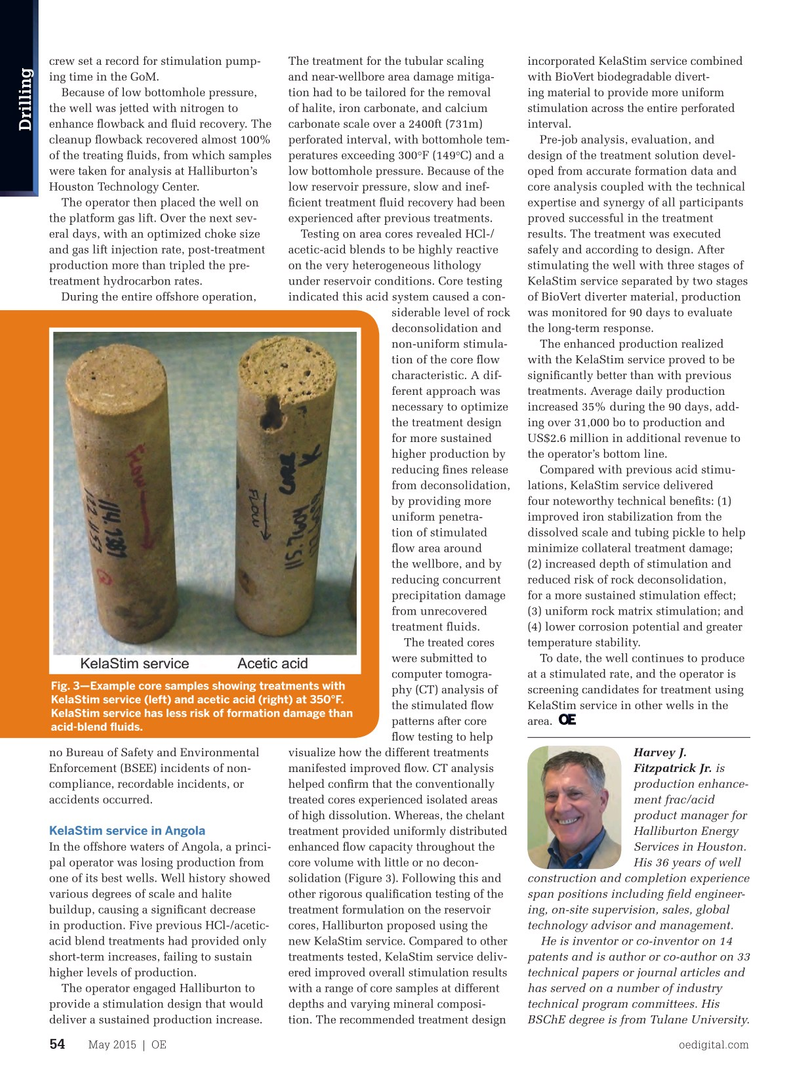
Page 52: of Offshore Engineer Magazine (May/Jun 2015)
Read this page in Pdf, Flash or Html5 edition of May/Jun 2015 Offshore Engineer Magazine
crew set a record for stimulation pump- The treatment for the tubular scaling incorporated KelaStim service combined ing time in the GoM. and near-wellbore area damage mitiga- with BioVert biodegradable divert-
Because of low bottomhole pressure, tion had to be tailored for the removal ing material to provide more uniform the well was jetted with nitrogen to of halite, iron carbonate, and calcium stimulation across the entire perforated enhance fowback and fuid recovery. The carbonate scale over a 2400ft (731m) interval.
Drilling cleanup fowback recovered almost 100% perforated interval, with bottomhole tem- Pre-job analysis, evaluation, and of the treating fuids, from which samples peratures exceeding 300°F (149°C) and a design of the treatment solution devel- were taken for analysis at Halliburton’s low bottomhole pressure. Because of the oped from accurate formation data and
Houston Technology Center. low reservoir pressure, slow and inef- core analysis coupled with the technical
The operator then placed the well on fcient treatment fuid recovery had been expertise and synergy of all participants the platform gas lift. Over the next sev- experienced after previous treatments. proved successful in the treatment eral days, with an optimized choke size Testing on area cores revealed HCl-/ results. The treatment was executed and gas lift injection rate, post-treatment acetic-acid blends to be highly reactive safely and according to design. After production more than tripled the pre- on the very heterogeneous lithology stimulating the well with three stages of treatment hydrocarbon rates. under reservoir conditions. Core testing KelaStim service separated by two stages
During the entire offshore operation, indicated this acid system caused a con- of BioVert diverter material, production siderable level of rock was monitored for 90 days to evaluate deconsolidation and the long-term response.
non-uniform stimula- The enhanced production realized tion of the core fow with the KelaStim service proved to be characteristic. A dif- signifcantly better than with previous ferent approach was treatments. Average daily production necessary to optimize increased 35% during the 90 days, add- the treatment design ing over 31,000 bo to production and for more sustained US$2.6 million in additional revenue to higher production by the operator’s bottom line.
reducing fnes release Compared with previous acid stimu- from deconsolidation, lations, KelaStim service delivered by providing more four noteworthy technical benefts: (1) uniform penetra- improved iron stabilization from the tion of stimulated dissolved scale and tubing pickle to help fow area around minimize collateral treatment damage; the wellbore, and by (2) increased depth of stimulation and reducing concurrent reduced risk of rock deconsolidation, precipitation damage for a more sustained stimulation effect; from unrecovered (3) uniform rock matrix stimulation; and treatment fuids. (4) lower corrosion potential and greater
The treated cores temperature stability.
were submitted to To date, the well continues to produce computer tomogra- at a stimulated rate, and the operator is
Fig. 3—Example core samples showing treatments with phy (CT) analysis of screening candidates for treatment using
KelaStim service (left) and acetic acid (right) at 350°F. the stimulated fow KelaStim service in other wells in the
KelaStim service has less risk of formation damage than patterns after core area. acid-blend fuids. fow testing to help
Harvey J. no Bureau of Safety and Environmental visualize how the different treatments
Fitzpatrick Jr. is
Enforcement (BSEE) incidents of non- manifested improved fow. CT analysis production enhance- compliance, recordable incidents, or helped confrm that the conventionally ment frac/acid accidents occurred. treated cores experienced isolated areas product manager for of high dissolution. Whereas, the chelant
KelaStim service in Angola
Halliburton Energy treatment provided uniformly distributed
In the offshore waters of Angola, a princi- enhanced fow capacity throughout the
Services in Houston. pal operator was losing production from core volume with little or no decon-
His 36 years of well one of its best wells. Well history showed solidation (Figure 3). Following this and construction and completion experience various degrees of scale and halite other rigorous qualifcation testing of the span positions including feld engineer- buildup, causing a signifcant decrease treatment formulation on the reservoir ing, on-site supervision, sales, global in production. Five previous HCl-/acetic- cores, Halliburton proposed using the technology advisor and management. acid blend treatments had provided only new KelaStim service. Compared to other He is inventor or co-inventor on 14 short-term increases, failing to sustain treatments tested, KelaStim service deliv- patents and is author or co-author on 33 technical papers or journal articles and higher levels of production. ered improved overall stimulation results has served on a number of industry
The operator engaged Halliburton to with a range of core samples at different technical program committees. His provide a stimulation design that would depths and varying mineral composi-
BSChE degree is from Tulane University.
deliver a sustained production increase. tion. The recommended treatment design
May 2015 | OE oedigital.com 54 052_OE0515_D&C1_Halliburton.indd 54 4/20/15 3:19 PM

 51
51

 53
53